| Columns Retired Columns & Blogs |
30 minutes into this Ortofon factory tour... https://youtu.be/qZViieA6OAM
Of course if you're an Ortofon fan you'll want to watch it all...
Johannsen went on to explain how Selective Laser Melting—which, in some previous Ortofon models, was used to manufacture small frame-style cartridge bodies—can be used to make a better SPU shell: "The lasers melt very fine powder. In some areas of the housing, if you decide to melt some of the powder but not all, you can—so you can decide the properties of the housing from one area of the housing to another. This is additive manufacturing—not subtractive."
In other words, SLM is the opposite of machining a product from a solid, homogeneous billet; if you wish to make a non-massive product immune to resonances by strategically varying its density, the former manufacturing technique will succeed where the latter fails.
Johannsen also spoke of the subtle differences between the SPU Century's suspension and those of other SPUs: "The rubber suspension in any Ortofon moving-coil cartridge has two functions: damping resonances in the needle-vinyl interface and applying the appropriate stiffness [to the cantilever]. This is the first time we have used a Shibata stylus on an SPU, and the [stylus-to-groove] interface created by that profile has influence on this resonance. So you can choose the rubber compound to give the right compliance and the right damping. We are producing our own compounds for our suspensions, so we can make these parts—in this case, the rubber suspension between the armature and the pole piece. So we have two ways of tuning, by adjusting the pre-tension put into the rubber and determining what compound to use. We adjust these until we have the sound that we want."
And sound is still the ultimate determinant, according to Johannsen, who spoke passionately about making sure that this newest SPU sounded like an SPU—for which reason, in the Century, Ortofon reverted to the same combination of magnetically permeable armature and alnico magnet that had characterized the very first SPUs: "Having this square armature made out of pure iron really enhances the influence of the magnet. We use a magnetic system with a quite big alnico magnet, which behaves very differently from a system with a neodymium magnet. Each time when you make a new SPU, you adjust this system."
As for the SPU Century's status as a limited-edition Ortofon, Johannsen admitted that "I have been part of spreading some misinformation: I told you we are going to limit it to 250 pieces. After coming back from the Munich show, where we got so much good feedback from people, we decided that 250 would be too little. We decided to raise it to 350 pieces." Johannsen's fondness for the product may also have played a role: As the man who designed some of Ortofon's most modern, high-tech phono cartridges admits, "At home, I have had prototypes running of the MC Century and the SPU Century for two years. I love both of them!"
As for world happiness, Johannsen declined to play the nationalist. "Is this special to the Danish? I'm not so sure—lately, some people have made it so for us. But I'm sure you can have just as much hygge where you live."
At the moment, I surely do.
A grander note?
Speaking of Munich, during my visit to last May's High End show, some of the finest sounds I heard were from the system assembled for that event by the Italian brand Grandinote Audio, a maker of loudspeakers and low-powered solid-state amplifiers (footnote 5). According to company owner and chief designer Massimiliano Magri, the latter are designed and built more like tubed than transistor amps, so much so that he's coined for the company the trademark Magnetosolid.
Some background: At High End, manufacturers who exhibit on one of the central display floors rather than in one of the individual rooms at the floors' periphery, and who wish to play music, must do so in a portable, pre-fab room installed on the spot for that purpose. What those smallish spaces lack in their potential for good sound—bass response, in particular, suffers in the face of nonsturdy room boundaries—they make up for in their potential for atmospheric lighting and a pleasantly cocoonish feeling that has me once again reaching for the words cozy contentment. So it was in Grandinote's room, a comfortable and well-decorated space that offered the additional benefit of an excellent selection of non-audiophile recordings. Perhaps surprisingly, music reproduced in that FEMA-esque room was strikingly colorful, forceful, and involving.
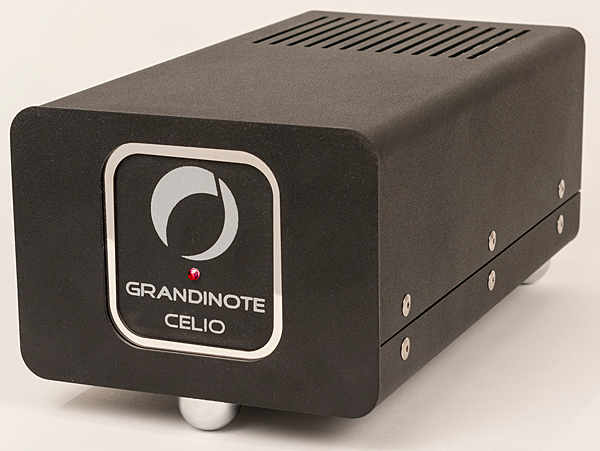
Four months after High End, I took delivery of Grandinote's Celio phono preamplifier ($8750), a smallish (7" wide by 5.75" high by 12.5" deep, 15.4 lb), roughly shoebox-shaped device whose steel case is finished in black crinkle paint. Inside, mounted on its steel chassis, a single circuit board takes up most of the available space; below the chassis is a toroidal mains transformer.
The Celio is a two-stage solid-state design using bipolar transistors for gain and buffering. Passive parts include JB film capacitors and Caddock resistors. Gain is user-selectable—45 or 66dB—by means of a dual-mono pair of rear-mounted toggle switches; also on the rear panel is a dual-mono pair of DIP switches, for selecting from 10 load impedances that range from 10 ohms to 47k ohms. The impedance values associated with various switch settings are printed on the rear panel itself—no problem if you lose the owner's manual (which appears to exist only on Grandinote's website).
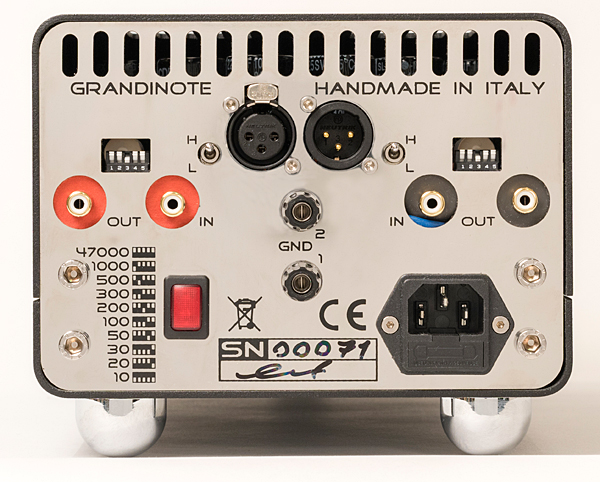
The Celio's throughput is single-ended rather than balanced: its left and right inputs and left and right outputs are all RCA jacks. But—just above them on the rear panel are one male and one female XLR jack, unlabeled. This sent me scurrying to the owner's manual, where I learned that one XLR is an input and the other an output, and that the Celio is capable of functioning as a balanced phono preamp—but only for a single channel. If balanced stereo throughput is desired, you must buy a second Celio.
Another curiosity is the Celio's on/off switch, a smallish illuminated pushbutton: I don't mind that it's on the rear panel, but I can't imagine why something the user can't see is made to light up. Moreover, as I learned during my first few hours with the Celio, the switch must be pushed inward farther than at first seems necessary before it will remain on: When that switch is pushed inward just a little, the front-panel power-indicator LED lights up and stays lit up for over 20 seconds before fading to dark. During the Celio's first day in my system, I wondered why it was turning itself off—until I realized that it hadn't actually been turned on, which requires a bit of effort. Okay, so maybe I do mind that the pushbutton is on the rear panel . . .
A final curiosity: Also on the rear panel are two ground terminals, labeled 1 and 2. At first I assumed they were channel specific: hobbyists such as I, who own true mono cartridges (footnote 6), in which signal appears on only two pins, have surely all experienced the need for single-channel grounding. But it turns out that Gnd 1 is a signal ground (for both channels), and Gnd 2 is a chassis ground. In my system—with a Garrard 301 turntable and EMT 997 tonearm, and with the Celio preceded by an Auditorium 23 Hommage T1 step-up transformer and followed by the line stage of my Shindo Monbrison preamplifier—I found that connecting my tonearm's ground lead to both of the Celio's ground terminals resulted in the best, most hum-free performance.
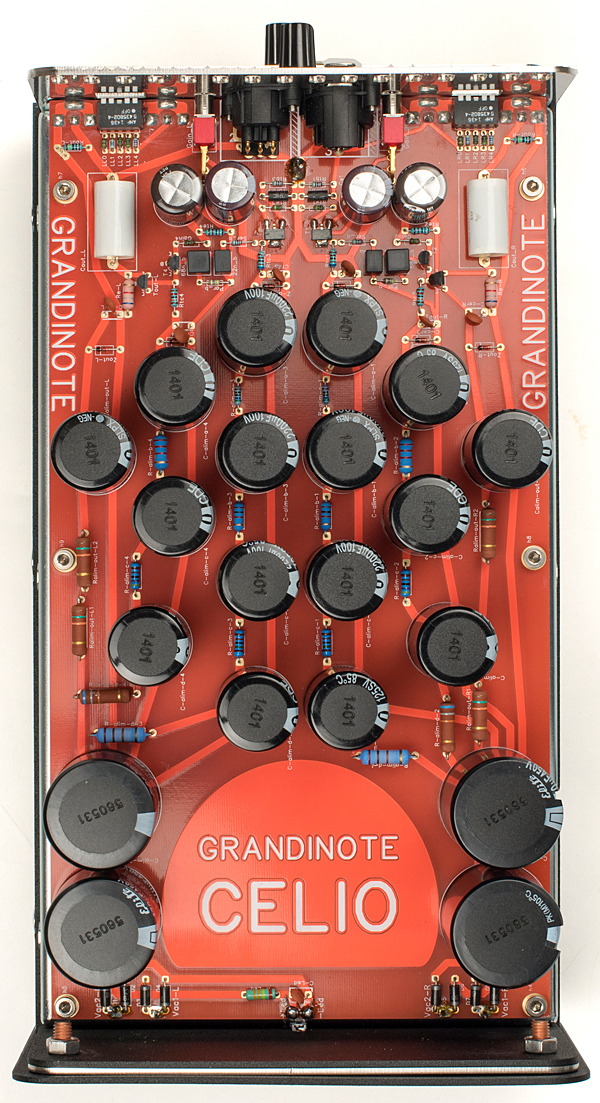
It's also worth noting that, while using my reference phono electronics, with the Grandinote Celio powered on but not hooked up to my system, audible hum intruded; when I turned off the Celio, the hum ceased. This suggests that the Grandinote phono pre is a fertile enough source of electromagnetic radiation that extra care should be taken in its siting.
When I used the Ortofon SPU Wood A pickup head with the Hommage T1 transformer in the system and the Celio at its lower gain setting, the latter proved sonically enjoyable and musically very competent. Listening to "Little Sadie," from Tony Rice's landmark Manzanita (LP, Rounder 0092), I heard a slightly different timbral balance from the phono stage built into my Shindo Laboratory Monbrison. With the Grandinote, notes played by double bassist Todd Phillips were a little less plummy, while the slightly reedy texture of Rice's voice was brought to the fore, albeit not at the expense of that voice's overarching richness. Musical timing was portrayed well: The Celio made clear a vanishingly slight ritard in the midst of a Dobro solo by the young Jerry Douglas.
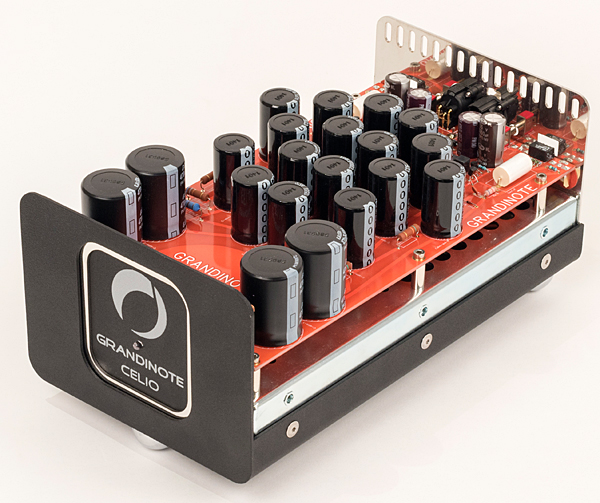
The Celio equaled the Shindo in excavating Ahmed Abdul Malik's double-bass lines in "In Walked Bud," from the Thelonious Monk Quartet's Misterioso (LP, Riverside/Analogue Productions RLP 1133), but not in its faithfulness to the kick in Roy Haynes's kick drum: Here and elsewhere, the tubed Shindo stage proved a better communicator of force than the solid-state Grandinote.
That said, the Celio brought to the sound of my system something unique: a "grippy" quality that made seemingly every musical sound—not just percussion instruments—seem more physical, more whole, than usual, and thus a little easier for my ears to grab on to and get comfortable with. (I'd say it was a "fatter" sound, but that implies tonal colorations, and I heard no such things.) Music played through the Celio had substance and color; I think those qualities aided my system in doing an even better job than usual of holding my attention.
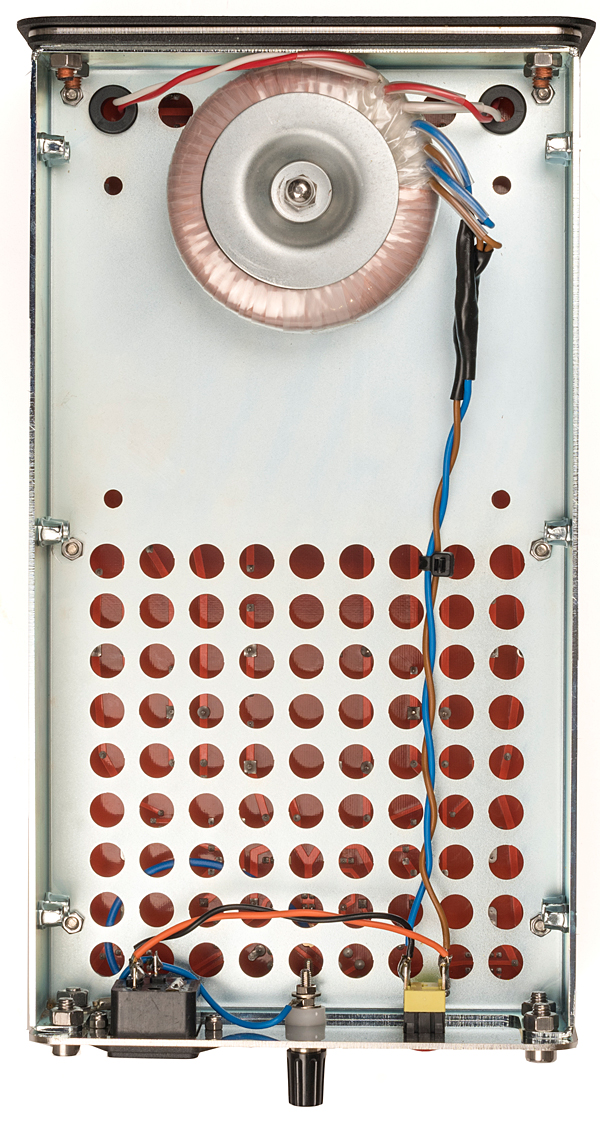
With the Grandinote Celio set for high gain, and without a step-up transformer, the sound was similar in terms of tonal balance and freedom from gross colorations—which is to say, similarly very good. But regardless of the load-impedance setting, by omitting the step-up transformer I also left behind the last word in physicality and human touch.
I hope to try at least one or two more cartridges with the Celio before returning it to the distributor. But so far, with a low-output, low-internal-resistance cartridge such as the SPU Wood A, its performance is impressive, notwithstanding the idiosyncrasies noted above. I'm somewhat less enthusiastic about the Grandinote's value for the money: Try as I may, I have difficulty seeing nearly $9000 worth of parts and workmanship in its simple, single enclosure. As such, the Celio is up against considerable competition, including the Lamm Industries LP 2.1 ($9390) and the Shindo Aurieges Equalizer Amplifier ($7895), the latter with its two beautifully made steel chassis and various hard-to-find NOS tubes and parts.
Footnote 6: My casual estimate is that only 10% of the cartridges claimed by contemporary manufacturers to be "true mono" really are. Sad to say, if and when a manufacturer makes that claim, your best bet is to disbelieve it until proven otherwise.

30 minutes into this Ortofon factory tour... https://youtu.be/qZViieA6OAM
Of course if you're an Ortofon fan you'll want to watch it all...

I've been a fan since I got my first MC cartridge in the '70's.
I even bought the small round step up transformer they made.
I grabbed that Concorde Century just because I could! Solid fun.
Retail points are tough. If this were half the price, I could swing it. It strikes me as an "exit level" product, which I mean as a compliment.
Thanks for that review.
The review of the top of the line Century that Mr. Fremer did was drool worthy, as well.

... a keeper?
Did AD decide to buy the review sample or shall it, perhaps, remain on a long-term loan?
Or, will a cartridge with a Shibata stylus never really be his cup of tea?

I don't think I'd let it go.


...workmanship in its simple, single enclosure. " quoted Art Dudley
I can't agree more.
This "Handmade in Italy" preamp is tagged for USD9,000, like Italian high fashhon!
Most of the money gone to building the power supply, leaving little money for the amplification part: 2 transistors NON-symmetric design. Unbelievable !
IMO, such simple topology can be designed to be powered by type D batteries,
cutting down the hugh cost of the clumsy power supply. The main advantage is zero AC hum noise & zero ground noise, better sound !
FYI, my brandname MC head amplifier comprising multi stages, using discrete transistors in a FULLY symmetric direct coupled Class A single ended push-pull output topology. The wisest way to eliminate power supply hum noise & ground noise (critical for moving coil cartridge head amps) is powered by batteries. It costed peanut vs this USD9,000 "Handmade in Italy" phono preamp.
IMO, design approach & price tag needed to be revised !!!!!!!
Jack L.
Canada

.. in order to let the preamplifier's volume knob function within a reasonable portion of its range." quoted Art Dudley.
What is "reasonable" portion of its range meant to you?
Jack L.